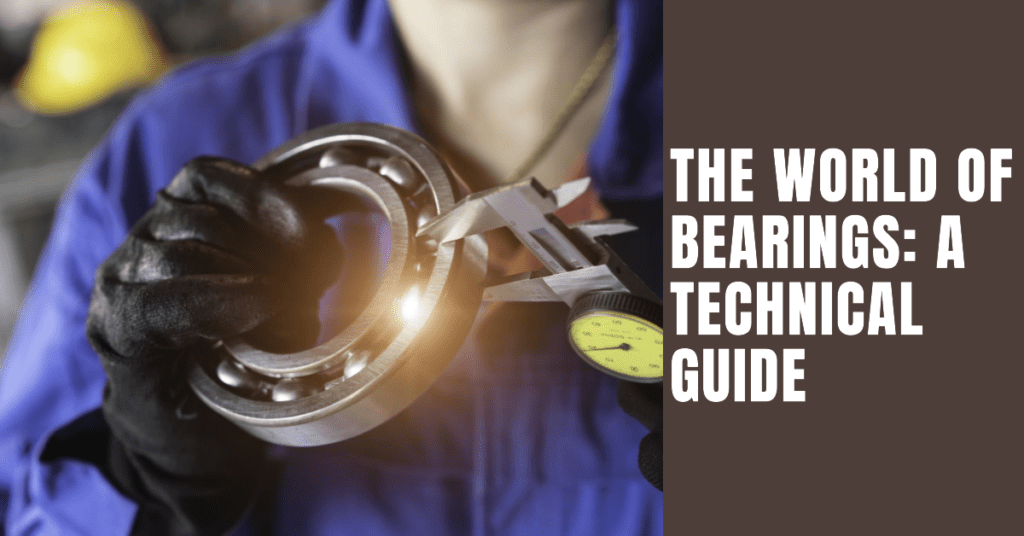
In the vast realm of mechanical engineering and machinery, bearings play a pivotal role. These seemingly simple components bear the brunt, quite literally, by supporting mechanical rotative applications and reducing friction between moving parts. They enhance efficiency, extend the life of machinery, and ensure smooth operations. But with a myriad of types available, understanding which bearing to use when and where can be daunting.
In this article, we will walk you through the diverse types of bearings, their materials, and their applications. So, let’s embark on this informative journey!
What Exactly is A Bearing?
The concept of bearings isn’t new. Ancient civilizations, such as the Egyptians, used a primitive form of bearings in the construction of their massive pyramids. Large logs were placed underneath heavy blocks of stone, allowing workers to roll these blocks over smooth surfaces, rather than dragging them.
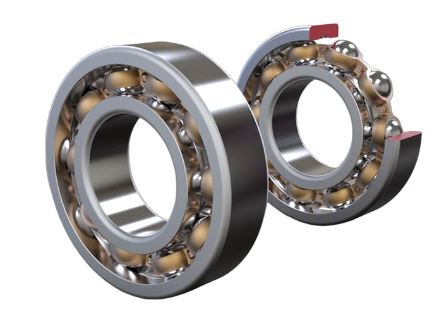
A typical bearing
In the current scenario, Bearings are indispensable components in the realm of mechanical engineering and machinery. Their primary purpose might seem simple at first glance: to reduce friction and aid in the desired motion between two or more parts.
At its core, a bearing is designed to reduce friction between moving parts and to support loads. When two surfaces slide against each other, they experience resistance, which produces heat and wears down the materials. A bearing minimizes this by offering a smoother, often rolling, medium between these surfaces. By doing this, the efficiency of machinery improves, the wear and tear are reduced, and energy consumption drops.
The Composition and Structure of Bearings
Bearings come in many shapes and sizes, tailored to their specific use, but most share a basic design:
- Inner race: This is the inner circle where the rotation (dynamic) action occurs. It’s precisely machined for smoothness.
- Outer race: This circle contains the inner race. It’s stationary and also machined for a smooth finish.
- Rolling element: Positioned between the inner and outer race, this component can be a ball, cylinder, barrel, or needle. It’s responsible for the rolling motion, thereby reducing friction.
- Cage: Also called a retainer, it keeps the rolling elements evenly spaced and ensures they don’t collide during operations.
Bearings play a crucial role in modern machinery, from vehicles to household appliances and industrial machinery. They operate silently in the background, reducing friction and ensuring smooth operations.
Bearings are found in wheels, transmissions, and differentials in vehicles, as well as in washing machines, air conditioners, motors, turbines, and conveyor belts. By reducing wear and tear, enhancing efficiency, and reducing energy consumption, bearings contribute to the extended lifespan and optimal functioning of machinery.
The Broad Classification of Bearings
Bearings, in their diverse forms, have paved the way for innovations across industries. While their primary function revolves around reducing friction between moving parts and carrying loads, the specifics of their application vary. This has led to the development of various bearing types, each with its design nuances and operational strengths.
Classifying Bearings by Load Type

Group of ball bearings isolated on white background 3d
Radial bearings
Radial bearings are mastered for situations where primary loads act perpendicular to the axis. They ensure stability in such orientations. Specifically designed for radial loads, radial bearings are commonly seen in applications like car wheel bearings, where they take on the essential role of supporting the vehicle’s weight.
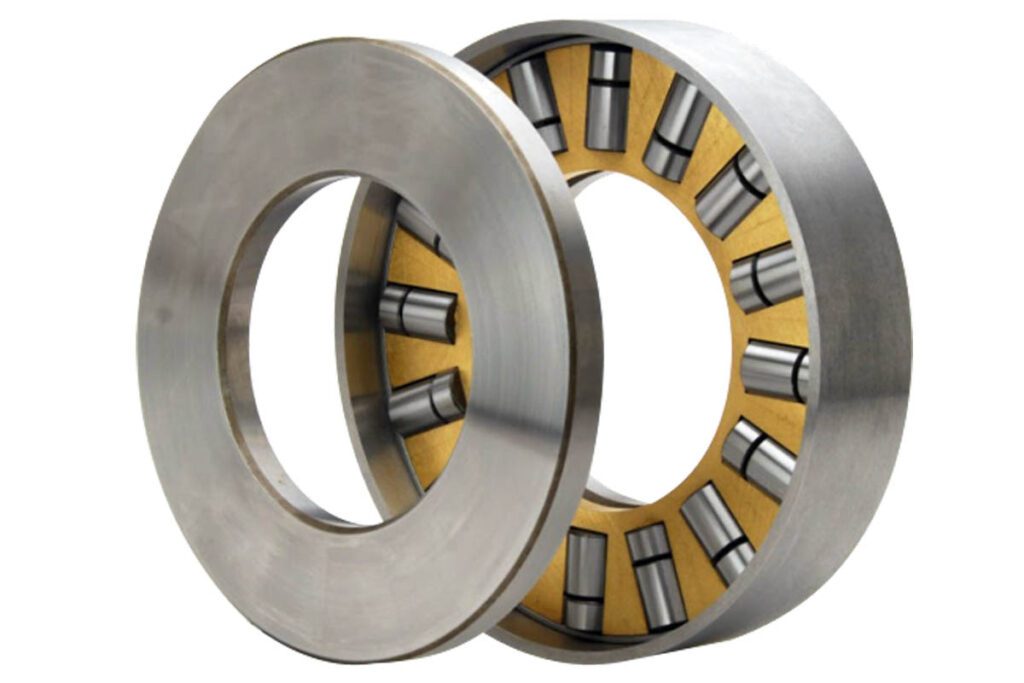
Thrust bearing
Thrust bearings are tailored for loads acting parallel to the axis, they’re the go-to for axial demands. These bearings are meticulously crafted to accommodate thrust or axial loads. Devices like helicopter rotors and turntables, which demand stability in axial orientations, heavily rely on them.
Bearings Distinguished by Operation Mode

Plain bearing
Sliding bearings (Plain bearings or Bushings**)** Operates g based on sliding motion, these bearings avoid the conventional rolling elements. With a smooth inner surface sliding against a shaft, sliding bearings are the chosen ones for applications with limited oscillatory movement, including large ship engines and hydropower plants.
Rolling Bearings are designed around rolling elements, they’re famed for reducing friction. Positioned between inner and outer races, these bearings offer efficiency and versatility. Their wide usage spans from simple skateboards to intricate industrial machines.
Distinctions Based on Rolling Element Shapes
Ball bearings utilize spherical balls, they’re versatile handlers of radial and thrust loads. By ensuring separation between bearing races, ball bearings showcase their adaptability in varied devices, from electric motors to hard drives.

Roller bearing
Roller bearings**,** Carrying cylindrical elements, they’re champions of high radial loads. Primarily designed to accommodate higher magnitudes of radial loads, they’re integral in machinery like conveyor belt rollers and vehicle axles.
A Look into Specialized Bearings
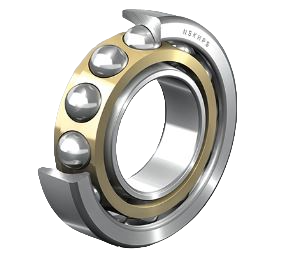
Angular contact bearing
Angular contact bearings are ideal for concurrent radial and axial loads, they’re high-speed stalwarts. Crafted for specific conditions, they ensure optimal performance under high-speed operations.
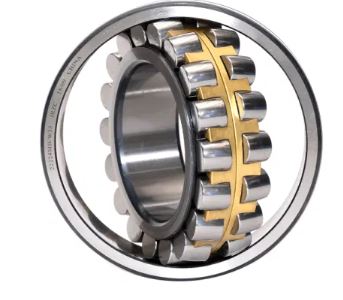
Self-aligning bearing
Self-aligning bearings are known for adaptability, they realign effortlessly, ensuring smooth operations. Their innate ability to adjust and realign makes them invaluable in varied applications, guaranteeing efficient performance even amidst deflections.
Deep Dive into Types of Bearings
There are diverse types of bearings, including ball bearings, roller bearings, ball thrust bearings, tapered roller bearings, and needle roller bearings. Each type has its unique design and operational strengths, making them suitable for specific applications. Let’s explore which bearings are the best fit for your machinery needs.
- Ball Bearings
Ball bearings are among the most ubiquitous types of bearings found in various machinery and applications. They employ small spherical balls that act as the rolling element. The primary purpose of these balls is to mitigate the rotational friction and support radial and axial loads. Their simple design and effectiveness have earned them a place in countless tools and machines, from skateboards to industrial equipment. Their proficiency in handling both radial and thrust loads simultaneously makes them a go-to choice for many applications.
- Roller Bearings
Roller bearings, unlike their ball-bearing counterparts, use cylinders as the primary rolling element. This design choice offers them the ability to carry heftier loads. The cylindrical design provides a larger contact area with the race, resulting in enhanced load-bearing capacity. They surpass ball bearings when it comes to supporting weight, due to the extended surface area of the rollers. Roller bearings further diversify into several sub-categories, with each catering to specific needs – from the tapered designs for handling combined loads to needle bearings for space-constrained applications.
- Ball Thrust Bearings
Delving into the specialized realm, ball thrust bearings emerge as the front-runners for managing axial or thrust loads specifically. Their design might seem simple, but their purpose is niche: to support axial loads in low-speed applications. A familiar instance of their use can be seen in bar stools, where they support the axial load while allowing for slow, smooth rotation. While they might not be suitable for high-speed operations, their efficiency in specific scenarios is undeniable.
- Tapered Roller Bearings
Tapered roller bearings stand out due to their ability to handle both radial and thrust loads concurrently. Their unique design features conically-shaped rollers and raceways, allowing them to support significant loads from multiple directions.

Tapered roller bearing
The automotive industry often employs these bearings, especially in car hubs, due to their durability and ability to withstand combined loads. Their tapered design ensures that each roller aligns within the bearing, providing optimal performance.
- Spherical Roller Bearings
With a design that boasts barrel-shaped rollers, spherical roller bearings are in a league of their own. Their most distinguishing feature is their self-aligning capability. These bearings can adjust to misalignment, often caused by shaft bending or installations errors, making them invaluable in scenarios where precise alignment is challenging. Primarily used in applications that involve heavy radial loads, they also accommodate moderate thrust loads, providing a balance between performance and adaptability.
- Needle Roller Bearings
Compactness and efficiency define needle roller bearings. Their slender design allows them to have a smaller radial cross-section than other bearings. This design choice doesn’t hinder their ability to support high radial loads.
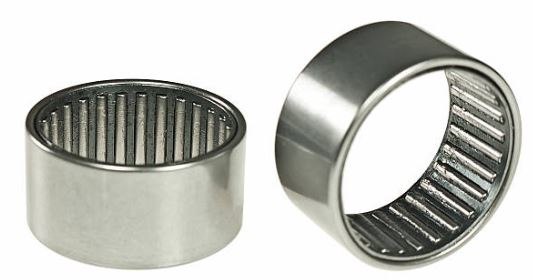
Needle roller bearing
Their slim form factor makes them an ideal fit for automotive transmissions and other areas where space is a constraint. Despite their reduced size, their performance in managing substantial radial loads without occupying much radial space is remarkable.
Bearing Materials: What Makes Them Reliable?
Bearings play an integral role in countless machinery and applications. Yet, their efficiency and longevity largely hinge on the materials used in their construction. Different applications have diverse requirements; thus, bearing materials are chosen based on specific needs, such as resistance to wear and tear, ability to withstand heat or reduction of friction.
Here, we delve into some primary materials used in bearing manufacturing and explore why they are trusted in this pivotal role.
Table: Overview of bearing materials
| Material | Key Features & Composition | Primary Benefits | Typical Applications & Notes |
|---|---|---|---|
| Steel (Chrome Steel/SAE 52100) | Chrome steel is commonly used for bearing manufacturing. | Strength, durability, wear resistance. Has good hardness properties and can handle significant loads. | Prolonged operational life, commonly used in various machinery and equipment. |
| Stainless Steel (AISI 440C) | Provides protection against corrosion. | Suitable for environments with moisture or chemical exposure. Offers good load-bearing capacity. | While slightly softer than chrome steel, it resists environmental factors effectively. |
| Ceramic (Silicon Nitride – Si3N4) | Popular for high-speed applications. | Low weight, resistant to high temperatures, non-conductive, low friction. | Can operate without lubrication in certain scenarios. |
| Plastic and Polymer (PEEK, Nylon) | Used in lightweight applications. | Can handle moderate loads, resistant to corrosion, non-magnetic. | Ideal for wet environments or chemical exposure. Suitable for medical equipment. |
| Babbitt Metal | A soft alloy of tin, antimony, and copper. | Provides cushioning, minimizes wear rate, and self-lubricating properties. | Used mainly in lined bearings, ideal for low to moderate load scenarios. |
| Bronze | The alloy of copper and tin. | Strong with good anti-friction properties, ensures effective heat dissipation. | Used for bushings and sleeve bearings; prevents metal-to-metal contact. |
Factors to Consider While Choosing the Bearing Type?
Choosing the right bearing type for an application is crucial. The wrong selection can lead to premature wear, unexpected failure, and increased operational costs. While it might be tempting to simply opt for the most robust or cost-effective option available, understanding the intricacies of the application is essential. Several factors play a pivotal role in this decision-making process:
- Load Capacity
Every bearing is designed to handle a specific load, categorized as either radial or axial. Understanding the nature and magnitude of the load is fundamental. Radial loads act perpendicular to the shaft’s axis, while axial loads act parallel. Some bearings can handle both. Determining the load a bearing needs to handle will help in selecting the appropriate bearing that won’t deform or fail under stress.
- Rotational Speed
Different bearings are suited to different speeds. For instance, while ball bearings are designed for high-speed applications, roller bearings can handle heavier loads but often at lower speeds. It’s vital to match the bearing’s design with the rotational speed of the machinery. In some applications, especially high-speed ones, minimizing friction becomes crucial.
- Rigidity
This refers to the bearing’s ability to handle deflection under load. In applications where precision is paramount, such as in CNC machines, a bearing with high rigidity is essential. This ensures the equipment’s alignment and precision are not compromised under stress.
- Operating Environment
Bearings operate in various conditions – from dry and dusty to moist and corrosive. The material and type of bearing should be chosen based on the operating environment. For instance, stainless steel bearings are ideal for moist conditions due to their corrosion resistance, while ceramic bearings might be suitable for high-temperature operations.
- Lifespan and Maintenance
Different bearings have varying service lives and maintenance requirements. While some bearings are designed for prolonged use with minimal maintenance, others might require regular lubrication and
Types of Bearings and Their Application
Bearings are intricate mechanisms that significantly reduce friction between moving parts, enabling machinery to operate smoothly. Their selection is typically based on various parameters, such as load, rotational speed, rigidity, and more. Let’s explore the various types of bearings and their respective applications.
1. Deep Groove Ball Bearings
Deep groove ball bearings are probably the most familiar bearing types. They handle both radial and axial loads and can operate at high speeds. Owing to their versatility, they’re used in a multitude of applications, from electric motors to home appliances such as washing machines.
2. Angular Contact Ball Bearings
With asymmetric designs, these bearings specifically cater to combined loads (both axial and radial). They often come in pairs due to their ability to handle thrust in either direction. These are often found in car hub wheel bearings, gearboxes, and jet engines because of their high-speed and precision capabilities.
3. Cylindrical Roller Bearings
These are characterized by cylinders as rolling elements. They’re excellent for high-radial load capacities. Cylindrical roller bearings are mainly used in large machinery where heavy loads and high rigidity are essential, like generators or large electric motors.
4. Tapered Roller Bearings
These bearings have tapered inner and outer raceways, making them capable of handling large radial and axial loads, primarily in one direction. They are commonly found in car hubs due to their ability to handle both radial and axial loads simultaneously. They are also used in industrial machinery, such as conveyor belt systems.
5. Spherical Roller Bearings
Their unique design enables them to handle heavy radial loads, moderate axial loads, and even misalignment. They are commonly found in applications where there may be potential misalignment or shaft deflection, such as mining conveyor belts and marine propulsion systems.
6. Thrust Ball Bearings
Thrust ball bearings are designed to handle axial loads and cannot support any radial load. They come in single and double-direction designs and are commonly used in applications like crane hooks and turntables, where axial loads are dominant.
7. Needle Roller Bearings
Slimmer than other roller bearings, they handle high radial loads with a reduced cross-section. Due to their compact nature, they’re prevalent in automotive transmissions and certain aerospace applications.
Table: Key Parameters for Bearing Selection
| Parameter | Description | Importance in Application |
|---|---|---|
| Load | The weight or force applied to the bearing | Determines bearing’s size and type for load capacity |
| Rotational Speed | The speed at which the bearing will operate | Influences lubrication needs and bearing type |
| Rigidity | How stiff or flexible the bearing needs to be | Critical for precision applications |
| Operating Temperature | The temperature range in which the bearing will function | Affects material and lubrication choice |
| Life Expectancy | Expected operational lifespan of the bearing | Influences material and design considerations |
| External Environment | Consideration of external factors like water, dust, or corrosive elements | Determines sealing and material requirements |
Prolean’s Bearings Manufacturing Services: A Deep Dive into Excellence
Prolean, a name synonymous with quality and precision, has set new standards in the realm of bearing manufacturing. As an industry leader, the company prides itself on its commitment to superior product offerings and the unmatched services it provides to its vast clientele.
Table: Features of Prolean’s bearing manufacturing services
| Aspect of Excellence | Benefit | Description |
|---|---|---|
| Cutting-Edge Technology | Enhanced production & precision | Ours utilizes advanced machinery to ensure every bearing meets global standards. This technology boosts production speed and assures our renowned precision. |
| Skilled Workforce | Precision & dedication in production | Comprising experts in the bearings industry, our team undergoes consistent training. Their expertise ensures precision and dedication in every bearing crafted. |
| Diverse Product Range | Satisfies diverse industry needs | Ours offers a product line from common ball bearings to specialized needle roller bearings, ensuring we cater to a variety of industries and demands. |
| Quality Assurance | Ensured durability & high standards | Beyond production, we focus on quality at every manufacturing stage. From sourcing to testing, we guarantee each bearing’s top quality and durability. |
| Sustainable Practices | Commitment to a greener planet | We adopt sustainable manufacturing methods, reducing waste, optimizing resources, and using recyclable materials, showcasing our dedication to the environment. |
| Customization Capabilities | Meets specific client needs | Acknowledging diverse client needs, we offer customization for unique sizes, materials, or designs, aligning perfectly with specified requirements. |
| Global Outreach | Accessibility & unmatched service | Our global network ensures our top-quality bearings are available to clients everywhere, reflecting our commitment to unparalleled quality and service. |
Conclusion
Bearings, though small in size, hold immense significance in the world of machinery and motion. As we’ve seen, their types, materials, and applications are diverse. Choosing the right bearing is crucial to ensure efficiency, reduce wear and tear, and guarantee the longevity of the machinery. With leaders like Prolean in the bearing manufacturing industry, one can rest assured of the quality, precision, and durability of bearings. After all, in motion, every minute detail matters!
FAQs
What are the different types of bearings?
The primary types include ball bearings, roller bearings, ball thrust bearings, tapered roller bearings, and needle roller bearings, among others.
Why are there so many bearing types?
Different machinery and applications require varying load capacities, friction resistances, and alignment capabilities. Hence, the diversity in bearing types.
What materials are bearings made of?
Bearings are commonly made from stainless steel, chrome steel, ceramic, and plastic.
How do I choose the right bearing?
It depends on the application, load type (radial or thrust), and environmental conditions. Consulting with experts like Prolean can guide you.
Are ceramic bearings better than steel?
Each has its advantages. Ceramic bearings are lightweight and can handle higher temperatures, while steel bearings are generally more durable.
Why is Prolean a top choice in bearing manufacturing?
Prolean combines technological advancements with precision and expertise, ensuring top-quality

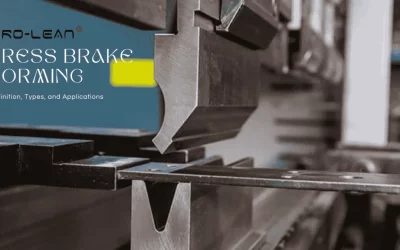
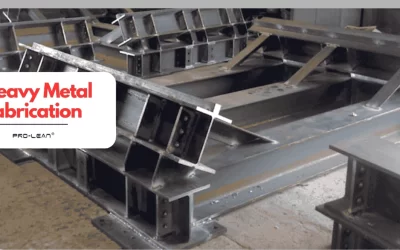
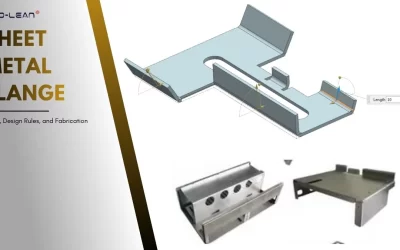
0 Comments